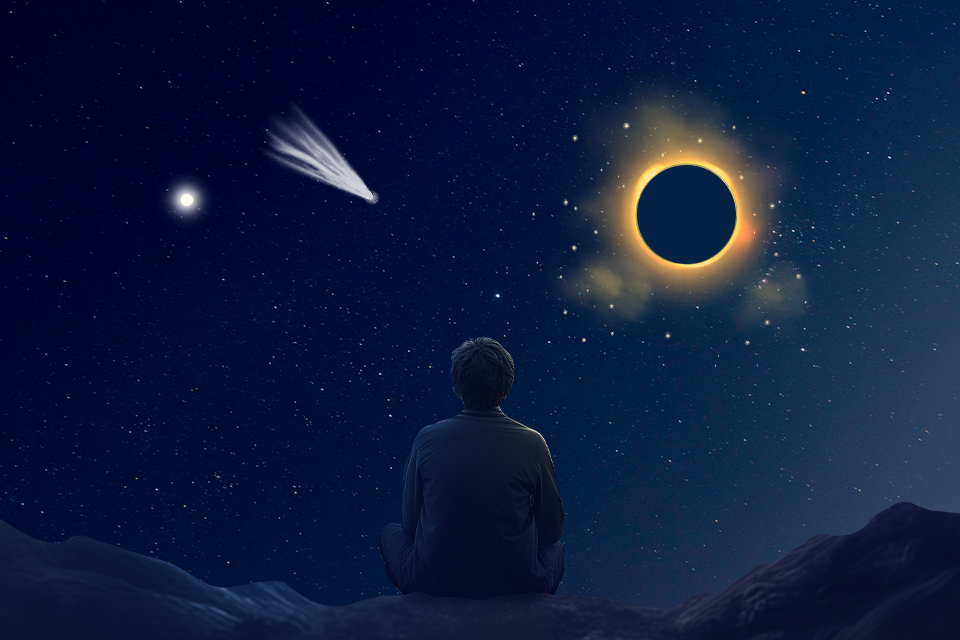In general, the year 2024 will be rich in interesting astronomical phenomena, and most of them will be able to be seen by Ukrainian observers. Foremost, these are comets that will exceed the 9th magnitude in brilliance. Two of them, Tsuchinshan-1 and Pons-Brooks, can already be seen in telescopes and binoculars with a lens diameter of at least 80 mm under good atmospheric conditions. And this is also without taking into account the bright “tailed stars” that may discover after the beginning of the year. On some days, several important events will take place at once: for example, on April 21, Jupiter will appear in the sky only 0.5° from Uranus, at the same time the maximum of the Lyrid meteor shower is expected and the perihelion of the already mentioned comet Pons-Brooks will pass.
On the other hand, the second year in a row will pass without the opposition of Mars. Also, during 2024, there will be no maximum elongation of Venus (and in general, the conditions for observing the nearest planet will not be very favorable). Saturn will begin a series of oppositions of the giant planets on September 8, and Jupiter will end on December 7.

Both solar eclipses of 2024 are observed only in the Western Hemisphere, and of the lunar eclipses in Ukraine, only a partial one with a small shadow phase will be visible, which will occur before dawn on September 18. On the evening of June 16, in the northeastern part of Ukraine, you can see how the Moon will cover Spica, the brightest star in the constellation Virgo. On the night of August 21-22, Neptune will hide behind the lunar disk for about half an hour.
The dates of the elongations of Mercury, the oppositions of the outer planets and Ceres, planetary connections (note the very close approach of Mars to Neptune), as well as phenomena related to the Moon and the Sun, are listed below. Among other events, the maxima of the most powerful meteor showers and occultations visible from the territory of Ukraine are mentioned.
January 3
- The Earth is in perihelion
January 4
- Maximum of Quadrantids
January 12
- Mercury is in the greatest western elongation
January 27
- Mercury is 0.3° north of Mars
January 30
- Comet Tsuchinshan-1 (62P/Tsuchinshan) at 0.499 AU from Earth
February 14
- Comet C/2021 S3 (PanSTARRS) is in perihelion
February 22
- Venus is 0.6° north of Mars
March 10
- The Moon is closest to Earth in 2024 (356,893 km)
March 15
- Comet C/2021 S3 (PanSTARRS) at 1,298 AU from Earth
March 20
- Vernal Equinox
March 21
- Venus is 0.3° north of Saturn
March 24
- Mercury is in the greatest eastern elongation
March 25
- Penumbral lunar eclipse
April 8
- Total solar eclipse (visible in the Pacific Ocean, North America and the North Atlantic)
April 10
- Mars is 0.4° north of Saturn
April 11
- Comet Pons-Brooks (12P/Pons-Brooks) is 3° west of Jupiter.
April 21
- Maximum of Lyrids
- Comet Pons-Brooks is at perihelion
- Jupiter is 0.5° south of Uranus
April 29
- Mars is 2° south of Neptune
May 5
- Maximum of η-Aquariids
May 9
- Mercury is in the greatest western elongation
June 16
- The Moon covers the Spica (α Virgo)
June 20
- Summer Solstice
June 29
- Comet Olbers (13P/Olbers) is at perihelion
July 5
- The Earth is in Aphelia
July 6
- The dwarf planet Ceres is in opposition
July 20
- Comet Olbers at 1,895 AU from Earth
July 22
- Mercury is in the greatest eastern elongation
August 12
- Maximum of Perseids
August 21
- The Moon covers Neptune
September 5
- Mercury is in the greatest western elongation
September 8
- Saturn is in opposition
September 18
- Partial lunar eclipse (visible in Ukraine)
September 21
- Neptune is in opposition
September 22
- Autumnal Equinox
September 28
- Comet C/2023 A3 (Tsuchinshan-ATLAS) is at perihelion
October 2
- Annular solar eclipse (visible in the Pacific Ocean and South America)
October 9
- Maximum of Draconids
October 12
- Comet C/2023 A3 (Tsuchinshan-ATLAS) at 0.472 AU from Earth
October 17
- Supermoon of 2024
October 21
- Maximum of Orionids
November 11
- Maximum of Northern Taurids
November 16
- Mercury is in the greatest eastern elongation
November 17
- Maximum of Leonids
- Uranus is in opposition
December 7
- Jupiter is in opposition
December 13
- Maximum of Geminids
December 21
- Winter Solstice
December 25
- Mercury is in the greatest western elongation
Follow us on Twitter to get the most interesting space news in time
https://twitter.com/ust_magazine


